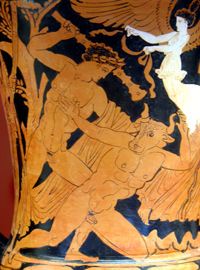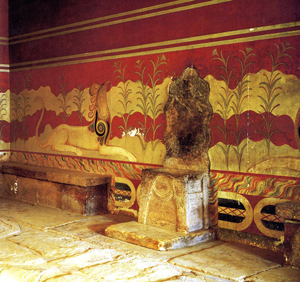Theseus' Early Life
Theseus was the son of Poseidon and Aethra, but raised as the son of Aegeus, king of Athens. When Theseus was still young he was sent away to Troezen. Aegeus feared for his life, as his fifty cousins had designs on the throne.
Theseus' Adventures on the Road to Athens click to see a map
When Theseus grew up it was time to return to Athens. He was warned against travelling by road, for since Heracles had been gone the country was filled with bandits and monsters. But Theseus, whose hero was Heracles, fancied himself as a great warrior and faced all these dangers.
At Epidauros he slew Periphetes the bandit who used to kill travellers with his club. Theseus took the club for himself.
Near Corinth, the brigand Sinis would tie people to the tips of two pine trees, then releasing them the trees would tear them apart. Theseus gave Sinis the same punishment.
Near Eleusis, Theseus defeated the giant Cercyron, by wrestling him and dashing his head against the ground.
Another villain, Procrustes, had a unique torture. If a guest was short he would lie on a long bed and Procrustes would stretch him to fit; if tall, he was put on a short bed and his legs cut short to fit. In this case too Theseus inflicted Procrustes' own punishment on him.
In Athens
At last Theseus reached Athens, and after more incidents, revealed himself to his father, who was overjoyed to see him.
But at this time the people of Athens were sad. Every nine years, the king of Crete, Minos, forced them to send seven youths and seven maidens to be sacrificed to the Minotaur, a fearsome beast, a man with a bull's head. The young ones would be sent into the Minotaur's lair, a labyrinth, get lost, and be devoured one by one. Now the nine years were up.
Theseus made his father send him in place of one of the young men, promising to slay the Minotaur. Aegeus made him promise to raise a white sail on his return if he had been successful, in place of the black sail of mourning. Before leaving for Crete, Theseus sacrificed to Aphrodite and prayed for her to help him.
Theseus
King Minos met Theseus and his companions. With him was his daughter Ariadne, whom Aphrodite made fall in love with Theseus.
Before entering the labyrinth, Ariadne offered to help him if he would promise to take her back to Athens as his wife. Theseus agreed, and she gave him a ball of wool, telling him to let it trail behind him as he wound through the maze. After killing the monster he could find his way out by following the wool.
The Minotaur
Theseus entered the maze, letting the wool unwind as Ariadne had said. At last he reached the centre of the labyrinth, the home of the Minotaur. Man and monster fought, the beast using his great horns to try to impale the hero. But Theseus finally felled him with a stroke of his sword. He made his way out following the wool, and with Ariadne and the other young men and women he escaped from Crete.
Naxos
The ship stopped at the island of Naxos so everyone could rest. Despite his promise to Ariadne, Theseus did not love her and knew the Athenians would not accept her. He therefore woke his companions up and they left her on the beach. Awaking, Ariadne was heartbroken, and she called on Zeus to punish Theseus. Later the god Dionysos arrived in Naxos, fell in love with Ariadne, and took her as his bride.
The Return
Nearing Theseus, Zeus made Theseus forget his promise to his father and did not raise the white sail. Aegeus, watching from the Acropolis, saw the black sail, and believing his son had been killed by the Minotaur, threw himself in grief into the valley below. Some say he jumped into the sea, which still bears his name - the Aegean. And so Theseus returned to find his father dead.
King of Athens
Theseus became king, and was remembered by Athenians for having united the local area, Attica, into one community. and for beginning the Panathenaia, the festival of Athena which took place every four years. Other adventures included a visit to the Amazons, a race of warrior women, in the company of Heracles.
Theseus fights Procrustes
Theseus and the Minotaur

Ariadne asleep on the beach










